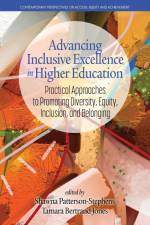von Tamara Bertrand Jones
73,00 €
The primary aim of this text is to provide educators with specific strategies for engaging in equity and inclusion work on college campuses. We include the perspectives of faculty and staff with a range of experiences and expertise to address current topics evolving at various levels and functional areas in the academy. Rather than replicate findings and recommendations established in extant literature, we provide faculty, staff, and graduate students with the insight and tools they will require to transform established recommendations into actionable solutions and promising practices. This book offers theoretical and practical approaches to evolving diversity, equity, and inclusion concerns in higher education. The core themes of this volume center on diversity, equity, inclusion, and belonging in higher education. While some educators use these terms interchangeably, we define diversity as a concept that envelopes several modes of social identity, including race, ethnicity, gender, ability, sexual orientation, faith/non-faith affiliation, size, veteran's status, etc. The practice of fortifying representation amongst minoritized populations without making considerations for structure and support has been the primary model for diversifying the academy for the past 40 years. Within the context of higher education and diversity, our conversation shifts beyond ensuring marginalized communities are represented. Within each chapter, the contributing authors address a wide range of diversity, equity, inclusion, and belonging topics that are unique to their positionality as educators in the postsecondary sector. As editors, we intentionally identify authors with diverse professional backgrounds who offer a range in their approaches to addressing emergent trends in their respective areas in higher education. In addition to submitting manuscripts that engage critical examinations of diversity, equity, and inclusion in the postsecondary sector, authors were encouraged to design supplemental material for their chapters, such as training modules, study guides, case studies, guides for utilizing critical research approaches and design, and interactive activities that can be replicated in various settings on campus (e.g., the classroom, residence halls, student organization trainings, etc.).

